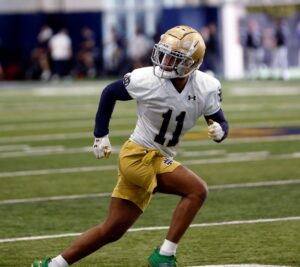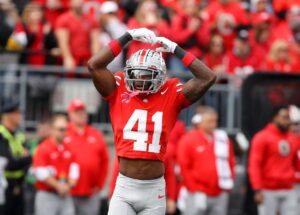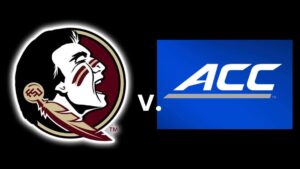As the Notre Dame offense struggled at the start of the season, offensive coordinator Tommy Rees’ play calling and general coaching prowess came under fire. Without Ian Book, Rees’ flaws were too obvious, some fans and analysts declared. Others said that Rees was too predictable, or he didn’t get the ball to his best players. All of it led to an ugly, stagnant offense that struggled to accomplish much of anything. Amidst a quarterback controversy, they had just 17 points through three quarters against Toledo. They notched just 10 first-half points against Purdue and matched that total through three quarters against Wisconsin. It finally caught up to the Irish in Week 5, as they scored 13 points in a 24-13 defeat to Cincinnati.
A week later, Notre Dame’s quarterback controversy came to a head. With cries to start backup Drew Pyne growing louder, the Irish stuck with transfer Jack Coan against Virginia Tech. When Coan struggled again, it was freshman Tyler Buchner taking snaps instead of Pyne. When Buchner got hurt, Coan re-entered and led two clutch drives to secure a 32-29 victory. Notre Dame garnered some momentum with the win, but they were limping into their bye week with a broken offense.
That was then, this is now
It’s hard to believe, but that Virginia Tech game was now 5.5 weeks ago. Since returning from bye, Notre Dame’s offense has been lightyears better. The Irish are averaging 34.25 points per game since the bye. But it’s more than points per game. In the first six games, Notre Dame notched 31.3 points per contest, so only marginally worse. However, that came with caveats. They had two defensive touchdowns and a kick return score versus Wisconsin. They were held scoreless in eight different quarters. At one point, Coan was held scoreless on 30 drives in a 37-drive span.
In the last four games, Notre Dame has had just three scoreless quarters. Two came against Navy, who held the ball for drives of 9 minutes and 44 seconds and 7:36 in those periods. And the other came in the fourth quarter against Virginia when the Irish were notably running the clock out. Adding on to that improved consistency, the games have been much more comfortable for the Irish. In the past four contests, they’ve trailed in the second half for a combined 58 seconds. They’ve only trailed at any point in the game on two occasions – down 3-0 versus Navy and 20-17 early in the third quarter against UNC.
There is a multitude of reasons for Notre Dame’s offensive turnaround. Better offensive line play has been the most noticeable on-field improvement. However, after taking so much of the criticism, it’s only fair that Rees gets the credit for this resurgence.
Rees’ Play Calling Maturing With Time
Rees’ play calling has often been critiqued as vanilla and boring. This was true even last year when the Irish offense was rolling for much of the season. With less margin for error this season, the offensive predictability quickly became a death knell for the Irish. However, after the bye week, Rees has put on a clinic in adjusting the offense, even with a host of injuries taking out the second half of his running back tandem, damaging the depth of his tight end room, causing a revolving door at offensive line, and more injuries at wide receiver.
The Tempo Offense
The tempo offense has been a huge reason for Notre Dame’s improvement. Coan was a traditional pro-style quarterback, so the idea that he would do better in this offense is odd. But ultimately, as the season progressed, it became clear that Coan thrived with quick reads. And so, Rees has tailored his playcalling to his signal-caller’s strengths. Against USC, 19 of Coan’s 29 dropbacks were under 2.5 seconds. He was 17-19 on those passes. Last weekend against Virginia, it was more of the same; on his 13 dropbacks of under 2.5 seconds, Coan completed 12 passes. He was just 3-7 for 23 yards on other pass attempts.
Such an offensive transformation should not be overlooked. Rees is in his second year as the offensive coordinator. He’s working with an entirely different quarterback and an offensive line that lost four contributors to the NFL. To run an entirely different offense and get immediate results is exceptionally impressive.
First-half Pressure
Rees’ play calling has also become much more aggressive. He’s not letting the Irish sit around in close games. He’s coming out with the intention to score and score frequently. In the past four games, Notre Dame has scored on 12 of 18 first-half drives (excluding two drives that ran out the clock). They’ve punted in the first half on just three occasions.
Simply, Notre Dame has been better on every down. Efficiency on first or second down is measured as getting 50% of the yards needed for a first down, while on third down, it’s measured by moving the chains. Notre Dame has been solid on first down, operating just under 50% efficiency. However, the Irish have really made a name for themselves on second and third down, particularly in the first half. In the first half of their last four games, the Irish rolled up 63% and 62% efficiency on second and third down, respectively, extending drives. This has in turn allowed the defense more rest, and Notre Dame has turned in two straight very complete efforts against Navy and Virginia.
Rees’ Play Calling Becoming More Creative
One particular play stood out last week against Virginia. The Irish lined up in a two-back offensive formation. That’s been a rarity in the tempo offense – so with running backs Kyren Williams and Chris Tyree in the game, a first-down run was certainly the expectation. The Irish did run it – with wide receiver Lorenzo Styles. Styles took a reverse handoff for 30 yards to set up an eventual touchdown in the first half. It was one of two wide receiver reverses run by Notre Dame in the contest.
The Styles’ reverse was just one example of improved creativity in Rees’ playcalling. While the Irish don’t give Styles a ton of volume in the passing game, Rees is finding ways to get his best athletes the ball. Styles had two touches in the first six games – he has nine in the past four. And the same goes for Kyren Williams. Even at times when the run game wasn’t working, Rees is figuring out ways to get his best all-purpose player the ball. Williams averaged 18 touches per game over the first five contests but 24 over the last five.
Managing The Quarterbacks
While Coan is entrenched as the top quarterback for the Irish, Buchner continues to get reps. And after some experimentation, Rees has balanced the situation well. In the past four games, Buchner has gotten reps here and there, leading a few key drives. Buchner has been very efficient, carrying 12 times for 48 yards and completing all eight of his pass attempts for 94 yards. With three capable quarterbacks on the roster, and two getting regular playing time, Rees has a unique situation on his hands, and his recent management of the conundrum has been masterful.
Coach of the Future
Rees’ play calling and general ability as a young coordinator was questioned greatly at the start of 2021. But as Notre Dame has improved, the Irish fanbase has been quick to forget, or overlook, the contributions of their 29-year-old offensive coordinator.
Defensive coordinator Marcus Freeman has been heralded as the potential Brian Kelly successor and the prodigy on the coaching staff. But don’t discount what Rees has accomplished. In his second year as a coordinator, Rees has directed two wildly different offenses to successful seasons. In fact, last year the Irish ranked 35th in points per play. This year they’re 31st – and 13th in the past three games. The trend has been upwards for Notre Dame and for Rees. There are still battles to be won in the 2021 season, but the talent coming to South Bend in 2022 and 2023 is undeniable. With a young coach quickly gaining confidence, the future looks bright in South Bend.
Main Image courtesy Rivals.com






